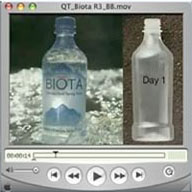The BIOTA Legend...
From the Windy City to the Wild West....
As a child growing up on Chicago's South Side, David Zutler would gaze at the skyline and dream of mountains. Now a successful businessman, he never imagined that 30 years later he would own the rights to the one of the world's highest natural alpine springs. How did it happen? People around Telluride "Blame It On The Altitude." ™
In the mid-1970's, Zutler followed his mountain dreams to Telluride, Colorado, and then on to Aspen where he started a successful home security business. Professional alliances led him to Los Angeles, where he provided security and bodyguard services to A-List celebrities and high-profile corporate executives. But the draw of the mountains stuck with Zutler, and he headed back to Telluride in the 1980's and built a successful real estate business with his brother Michael. Real estate brought him back to the mountains, but a news story forever changed his life and career path.
America's growing obsession with bottled water captured Zutler's imagination. What started out as a trendy niche had turned into a gold mine for water bottlers. According to the business story...bottled water held the number one spot for growth potential within the beverage industry. In fact, bottled water sales were surpassing sports drinks, soda and juice at warp speed (and still do). Analysts predicted that the market was only going to get larger. Consumers wanted bottled water. Period. Zutler looked up at the spectacular San Juan Mountains that day and decided he wanted to be a part of the water industry. The decision was easy...the next ten years were not.
Bottling premium natural water from one of the world's highest alpine springs sounds romantic. Setting up a business to bottle pristine water the right way was anything but. Large amounts of time, patience and tenacity moved Zutler toward his dream. When Zutler hiked high above Ouray to the natural spring located at an altitude of 9,010 feet and tasted the refreshing natural spring water, he knew he made the right decision. Extensive water testing of the spring produced amazing results. The water was pristine, high quality, pure and untouched.
High above the town of Ouray, hidden by nature, Zutler's dream was becoming a reality. After securing rights to the spring, Zutler had the water, but didn't want his water to be lost in the crowded bottled water shelves. He wanted a bottle different from all the other bottles on the market. An environmentalist at heart, he wanted an alternative to the standard petroleum based (PET) bottle. Zutler's extensive research found that consumer enthusiasm for recycling had dwindled. Additionally, only approximately 15 percent of plastics were actually being recycled. Statistics show that 30 million plastic water bottles are tossed into U.S. landfills each day. One bottle can take up to 1,000 years to break down. Using a PET bottle for the pristine water would only add to the recycling problem. Zutler was looking for an alternative solution. His search led him to studies at the University of Nebraska on a new plastic material. Made from corn, the new plastic was compostable but the research and development was still in its early stages.
Zutler was set on bottling the natural spring water the right way. It took 6 years until the research and development was complete and Zutler approached Cargill Dow, the company that was currently marketing the compostable material. Cargill Dow had just finalized specifications for a plastic resin made from a renewable resource, corn. Under the right conditions, the revolutionary new plastic would decompose in 75 to 80 days.
Zutler's timing could not have been better. He became a driving force in helping launch Cargill Dow's NatureWorks ™ PLA compostable plastic containers at a high-end natural food chain. Consumer response was overwhelming. This move positioned Zutler well to launch the first beverage in a compostable bottle.
Zutler had one of the world's highest natural spring waters and planned to bottle it in the world's first compostable/degradable bottle. The bottling plant was built in 2003/04 in the town of Ouray, Colorado, and key players from the beverage industry were hired. After ten years, the pieces were falling into place.
Now what do we call this product?
Throughout the process, people in the mountains would blame everything and anything on the altitude. "Blame It On the Altitude" ™ was a theme that was used repeatedly. So much so, that Zutler put a sign on his Telluride office with those very words. It was only fitting that Zutler's journey to making his dream a reality could be "blamed on the altitude." And then it struck him...that phrase could be the name of this new water. And so it was named...BIOTA is bottled at the source and sold in the world's first compostable water bottle.


